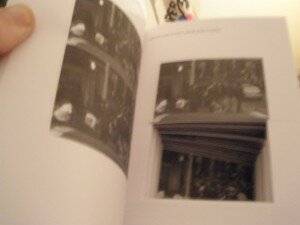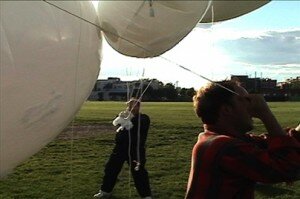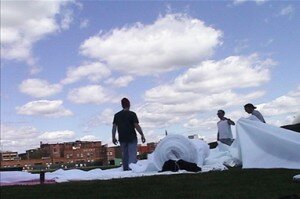Ben Luzzatto’s THE THEORY OF EVERYTHING, ABRIDGED (UDP, 2010) is one of those rare artifacts that transfers its own actual magic—and it is real magic—until the possessed begins to lift a bit toward the sky.
Ugly Duckling Presse has been summed up quite well as “a publishing collective specializing in experimental poetry and new editions of forgotten textual artist, producing lovely, cheeky books by authors you’ve probably never heard of but your grandchildren will likely read in college…a nesting ground for swans of the avant-garde poetry scene.” It’s true that I do feel personally attached to many titles UDP has produced (such as or ). THEORY is the most recent in its Dossier Series, which produced the wonderfully heady though deadly pretentious , and soon will bring out Dottie Lasky’s .
When I first held this particular book though, I do what I do with most books, hold it open it at a distance so I could see the entire cover spread. There was a figure of a someone umbilically attached to something, floating away, or recoiling. An astronaut? A cosmonaut? Where does that road go? You can’t see because of my shaky camera hands, but this is spot glossed over all the silver. This book was printed in Iceland by Oddi, and I haven’t read one word of it as of this point in my engagement and it’s practically trembling in my hands.
THE THEORY OF EVERYTHING, ABRIDGED, is broken into three sections. 1) The Aqueous Humor, 2) From Nonsense to New Sense, and 3) The Theory of Everything, Abridged. Each is a section of conceptual projects narrated by Luzzatto. The first section, The Aqueous Humor, we get what Luzzatto is after in his writing that oscillates from lyrical dreaminess to the more squared off language inherited from the Era of Theory:
“I don’t want to solve the mysteries of the universe, I want to know how I am a part of them…
The more you understand how you are already a part of something, which is the same as understanding how you see something, the more you can separate yourself from it. It is what it was, which already included you, but then it is also something else, which you know does not include you. You have remained together, but you have also become separate.”
Luzzatto’s ideas as he talks them out seem small compared to the immensity of his ideas as he documents them in photographs that accompany the text . We see images of the Cosmos, an umbrella made of funnels, and in section two, From Nonsense to New Sense, an ontological experiment where the subject ties a bungee cord to a tree (then dashes away from the tree without knowing the length of the rope)
Section three takes up most of the book, and one huge thing I’ve not mentioned yet is that this section involves yet another magickal feat of design, about 80% of the book has a hole through it:
This flip section shows two images of Luzzatto standing on a streer corner. The image below shows through the hole and remains static while the images above narrate a street scene in a city. The animation allows Luzzatto to complete his theory of everything:
“I see two of everything but I am usually not aware of it. A world that comes from me, which is expectation, and a world that comes to me, which is what I do not expect. Most of the time they do not appear to be separate.”
My favorite experiment of Luzzatto’s comes in section two, where the artist makes clouds (!) from helium-inflated urethane cells. I had a dream recently where I was back in my hometown hanging out with my buddy Cori and there was a street that was the actual place where all clouds were made. We were watching them appear out of nothing until they were heavy enough for the wind to lift towards to sky. Amazing. I don’t know what it means (what would Freud say?).
Luzzatto however makes clouds while he is actually awake, and it seems, he is quite good at talking about the whole thing (text following the images):
I assume there is a specific moment/distance at which the cloud disappears as it is rising up into the sky. When it is on its way up, still close to us and clearly a manmade cloud, it is more difficult to see the world that comes from me; it is more difficult to see a cloud that comes from my looking At a specific distance the cloud disappears. It looks like the other clouds in the sky…by making clouds disappear I am able to see how I see.
To see more about UDP, the book, and clouds,
<> <> <>








This is a truly great book, which, while reflecting the unique and eccentric ways of its author, taps into what we all experience trying to make sense of ourselves and the world we live in.
I loved it!!!!
Studs
I just read the article, but seems very drug trippy …